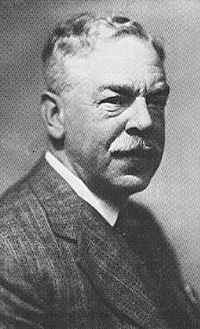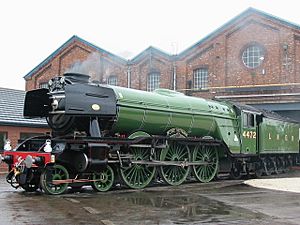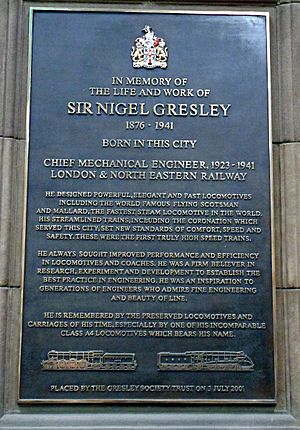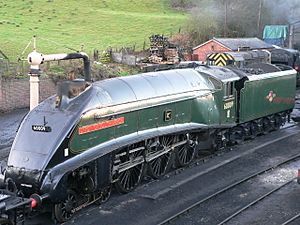Nigel Gresley facts for kids
Quick facts for kids
Sir
Herbert Nigel Gresley
|
|
|---|---|
 |
|
| Born | 19 June 1876 Edinburgh, Scotland
|
| Died | 5 April 1941 (aged 64) Watton-at-Stone, Hertfordshire, England
|
| Nationality | British |
| Occupation | Engineer |
| Engineering career | |
| Discipline | Locomotive engineer |
| Employer(s) | Great Northern Railway, London and North Eastern Railway |
Sir Herbert Nigel Gresley (born June 19, 1876 – died April 5, 1941) was a very famous British railway engineer. He designed some of the most well-known steam locomotives in Britain.
He became the Chief Mechanical Engineer (CME) for the London and North Eastern Railway (LNER). His designs included the powerful LNER Class A1 and LNER Class A4 engines.
One of his A1 Pacific locomotives, the Flying Scotsman, was the first steam train to officially go over 100 miles per hour (160 km/h) while carrying passengers. Another of his designs, an A4 named Mallard, still holds the world record for the fastest steam locomotive at 126 miles per hour (203 km/h).
Gresley's engines were known for looking great and working very smoothly. He invented a special system called the Gresley conjugated valve gear. This system made his three-cylinder engines run smoothly and powerfully, costing less to build than other designs.
Contents
Nigel Gresley's Life Story
Nigel Gresley was born in Edinburgh, Scotland, but grew up in Netherseal, England. He came from a family with a long history in Derbyshire.
After finishing school, Gresley started his training at the Crewe railway works. This was a big factory for the London and North Western Railway. He then continued his training at the Horwich works for the Lancashire and Yorkshire Railway (L&YR).
He quickly moved up in his career. By 1901, he was an assistant in the Carriage and Wagon Department. In 1902, he became Assistant Works Manager at Newton Heath, and then Works Manager the next year.
In 1904, he became Assistant Superintendent for the L&YR's Carriage and Wagon Department. A year later, he joined the Great Northern Railway (GNR) as their Carriage and Wagon Superintendent.
On October 1, 1911, he became the Chief Mechanical Engineer (CME) for the GNR. When many railway companies joined together in 1923 to form the LNER, Gresley was chosen to be their CME.
In 1936, he received an honorary Doctor of Science degree from Manchester University. He was also made a knight by King Edward VIII that same year. This meant he could use "Sir" before his name.
During the 1930s, Sir Nigel Gresley lived at Salisbury Hall in Hertfordshire. He enjoyed breeding wild birds and ducks in the moat around his home. Interestingly, among these birds were Mallard ducks, which is the same name as his famous record-breaking locomotive.
In 1936, Gresley also designed electric locomotives for a planned railway line between Manchester and Sheffield. This project was put on hold because of World War II but was finished in the early 1950s.
Sir Nigel Gresley passed away on April 5, 1941, after a short illness. He was buried in Netherseal, Derbyshire. Edward Thompson took over his role as the LNER's Chief Mechanical Engineer.
Remembering Sir Nigel Gresley
Many things have been created to remember Sir Nigel Gresley and his work.
In 2001, a special plaque was put up at Edinburgh Waverley railway station. It shows drawings of his famous Flying Scotsman and Mallard locomotives.
In Doncaster, a town where many of his famous steam engines were built, a public square was named Sir Nigel Gresley Square. It was opened in May 2012 by the Mayor of Doncaster and two of Gresley's grandsons.
One of his own locomotives, LNER Class A4 4498 Sir Nigel Gresley, is named after him.
A statue of Gresley was put up at King's Cross station in London on April 5, 2016. This was 75 years after he died. The sculptor, Hazel Reeves, originally wanted to include a duck with the statue. This was because Gresley loved breeding ducks and named some of his trains after birds, like Mallard. However, his grandsons felt this was disrespectful, so the duck was not included in the final statue.
Gresley's Amazing Inventions
Sir Nigel Gresley came up with many clever ideas and designs for railways:
- He invented the Gresley Conjugated Valve Gear. This was a special way to make 3-cylinder steam locomotives run very smoothly.
- He designed the largest passenger steam locomotive in the UK, the P2 2-8-2.
- He also designed the largest steam locomotive in the UK, the U1 2-8-0+0-8-2 Garratt.
- He created the V2 2-6-2 locomotive, which was nicknamed 'the locomotive that won the war'.
- His A3 'Flying Scotsman' 4-6-2 was the first steam train to officially reach 100 mph (160 km/h).
- His A4 'Mallard' 4-6-2 is still the fastest steam locomotive in the world, reaching 126.3 mph (203.3 km/h).
- Another A4, 'Silver Link', also held a world speed record for steam locomotives at 112 mph (180 km/h).
- He designed an experimental high-pressure LNER Class W1 'hush-hush' 4-6-4 locomotive.
- He developed the Silver Jubilee train, a special high-speed train.
- He introduced the articulated railway carriage. This design allowed train carriages to be joined in a way that made them more stable and smooth.
- He invented the corridor tender. This was a special part of the train that allowed crew members to walk through it while the train was moving. This meant trains could travel longer distances without stopping.
Locomotives Designed by Gresley
Here are some of the many locomotives Sir Nigel Gresley designed:
For the Great Northern Railway (GNR)
See: Locomotives of the Great Northern Railway
- GNR 536 Class (LNER Class J6) 0-6-0 (1911)
- GNR Class H2 (LNER Class K1) 2-6-0 (1912)
- GNR Class J21 (LNER Class J2) 0-6-0 (1912)
- GNR Class O1 (LNER Class O3) 2-8-0 (1913)
- GNR Class H3 (LNER Class K2) 2-6-0 (1914)
- GNR Class J23 (LNER Class J51) 0-6-0T (1915)
- GNR Class H4 (LNER Class K3) 2-6-0 (1920)
- GNR Class N2 0-6-2T (1920)
- GNR Class O2 2-8-0 (1921)
- GNR Class J23 (LNER Class J50) 0-6-0T (1922)
- GNR Class A1 4-6-2 (1922)
For the London and North Eastern Railway (LNER)
See: Locomotives of the London and North Eastern Railway
- LNER Class P1 2-8-2 (1925)
- LNER Class U1 Garratt 2-8-0+0-8-2 (1925)
- LNER Class J38 0-6-0 (1926)
- LNER Class J39 0-6-0 (1926)
- LNER Class A3 4-6-2 (1927)
- LNER Class D49 4-4-0 (1927)
- LNER Class B17 4-6-0 (1928)
- LNER Class V1 2-6-2T (1930)
- LNER Class P2 2-8-2 (1934)
- LNER Class A4 4-6-2 (1935)
- LNER Class V2 2-6-2 (1936)
- LNER Class W1 4-6-4 (1937)
- LNER Class K4 2-6-0 (1937)
- LNER Class V3 2-6-2T (1939)
- LNER Class V4 2-6-2 (1941)
- LNER No. 6701 Bo+Bo electric locomotive (1941)
See also
 In Spanish: Nigel Gresley para niños
In Spanish: Nigel Gresley para niños





